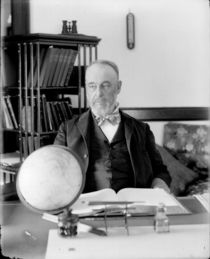 |
| Stickney Crater Mars Reconnaissance Orbiter March 2008. 6000 km image: NASA APOD |
Asaph Hall
 |
| Professor Asaph Hall (1829-1907) image wikimedia |
(Angelo Hall. An Astronomer's Wife: The Biography of Angeline Hall. Baltimore: Nunn & Company, 1908.)
In 1875 Hall was given responsibility for the USNO 26-inch (66-cm) telescope, the largest refracting telescope in the world at the time. It was with this telescope that he discovered Phobos and Deimos in August 1877. Hall also noticed a white spot on Saturn which he used as a marker to ascertain the planet's rotational period. In 1884, Hall showed that the position of the elliptical orbit of Saturn's moon, Hyperion, was retrograding by about 20° per year. Hall also investigated stellar parallaxes and the positions of the stars in the Pleiades star cluster.Hall found Deimos on August 12 and six days later on August 18, 1877 he discovered Phobos. The moons are named after the sons of Ares. In Greek mythology, Deimos was the son of Ares and the goddess of love, Aphrodite. Phobos was the son of Ares and goddess Enyo who accompanied her husband to battlefields. Deimos personified terror and Phobos fear both so vividly present in war.
At some point in the history of the Solar system an enormous object smashed into Phobos. The impact almost destroyed the moon leaving a huge crater named Stickney Crater in honor of Angeline Stickney Hall.
But never before has humanity seen the curious surface features of Phobos in such glorious detail as in the images taken by the HiRES cameras of the Mars orbiter in 2008.
Open the APOD image and see - the Moon of Fear is like a beautiful jewel, isn't it!
No comments:
Post a Comment